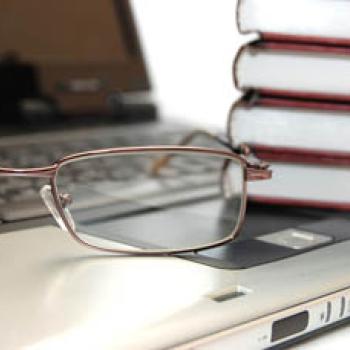Biography Project: Research and Class Presentation

- Preview |
- Standards |
- Resources & Preparation |
- Instructional Plan |
- Related Resources |
- Comments
Overview
Set the stage for high-interest reading with a purpose through a biography project. Students work together to generate questions they would like to answer about several well-known people, then each student chooses one of these and finds information by reading a biography from the library and doing Internet research. Students create a graphic organizer (a web) to organize the facts they have found and share what they have learned about their subjects through oral presentations. Students evaluate themselves and their classmates by using a rubric during the research and graphic organizer-creation process and by giving written feedback on one another's presentations.
Featured Resources
Bio-Cube: This planning tool can help students organize their research; use it as an extension to the lesson and have them outline the lives they' researched before writing their own biographies.
From Theory to Practice
- By using graphic organizers, students write or draw meanings and relationships of underlying ideas. This has been shown to improve students' ability to recall content.
- By summarizing information, students improve in including ideas related to the main idea, generalizing, and removing redundancy.
- By working in cooperative groups, students may increase their learning of reading strategies through peer discussion. They may also lead to better comprehension.
Common Core Standards
This resource has been aligned to the Common Core State Standards for states in which they have been adopted. If a state does not appear in the drop-down, CCSS alignments are forthcoming.
State Standards
This lesson has been aligned to standards in the following states. If a state does not appear in the drop-down, standard alignments are not currently available for that state.
NCTE/IRA National Standards for the English Language Arts
- 7. Students conduct research on issues and interests by generating ideas and questions, and by posing problems. They gather, evaluate, and synthesize data from a variety of sources (e.g., print and nonprint texts, artifacts, people) to communicate their discoveries in ways that suit their purpose and audience.
- 8. Students use a variety of technological and information resources (e.g., libraries, databases, computer networks, video) to gather and synthesize information and to create and communicate knowledge.
- 12. Students use spoken, written, and visual language to accomplish their own purposes (e.g., for learning, enjoyment, persuasion, and the exchange of information).
Materials and Technology
- School or classroom library with a broad selection of biographies
- Computers with Internet access and printing capability
- Index cards
Printouts
Websites
Student Objectives
Students will
- Learn to ask relevant questions before beginning a research project
- Learn to take notes and categorize information as they create graphic organizers
- Improve comprehension as they read and skim text for main ideas and details
- Develop research skills (book and Internet) with the purpose of teaching the class what they have learned
- Think critically as they use rubrics and written feedback to evaluate their classmates and themselves
Session 1: Before Reading
| 1. | Ask students what a biography is and show an example of one. Ask them what sort of things they would expect to find out about a person’s life in a biography. Share a biography of Martin Luther King, Jr. and ask students to work in pairs to generate questions about his life. Then ask for their ideas for how this information might be categorized (such as childhood events, turning points, things he is famous for, etc.) |
| 2. | Have students brainstorm famous people who might have biographies written about them, and write student responses on the board. |
| 3. | Pass out the Sample Web graphic organizer and discuss how categories and subcategories can be used to summarize a person's life achievements. In the sample for Martin Luther King, Jr., categories include "childhood and young adult," "beginning of his career," "turning points," "march on Washington," "what he wrote," and "assassination." |
| 4. | Have each student narrow the list on the board to three famous people they might like to study (they will narrow it down to one during the next session, depending on availability of biographies). |
| 5. | Pair off students to discuss the people they're interested in researching. Have them ask each other what they already know about the people. What things do they not know but want to find out? Have students work together to help each other generate questions about each of the people they would like to learn more about. |
Sessions 2 to 5
| 1. | Using your classroom or school library, have each student check out a biography of a famous person. The biography should be about one of the three people on the student's list from Session 1. |
| 2. | Pass out the Web Rubric and go over expectations and criteria with students.
|
| 3. | Use the sample web for Martin Luther King, Jr. to model for students how each item of the rubric applies to the creation of the web. |
| 4. | Ask students to skim (or preread) their biographies, focusing on the questions they generated during Session 1 about the selected person. Then have students work with their partners to group the information they find into appropriate categories and start a rough draft of their webs. |
| 5. | For homework (and, if time, in class), have students read independently as they complete their webs. |
| 6. |
Students can also use the list of suggested websites to add to their webs. |
| 7. | When the webs are complete, have each student use the Web Rubric to evaluate his or her own web. |
| 8. | Have each student share his or her web with a partner and give each other feedback and suggestions for improvement. The partner can fill out the same rubric using a different color. |
| 9. | Collect the students' webs, review them, and use the same rubric with another color to make suggestions for improvement. |
Session 6: After Reading
| 1. | Return the rubrics to students, giving them time to review the comments from you and their partners. Allow them the opportunity to make revisions to their webs. |
| 2. | Have students copy their webs neatly onto butcher paper and prepare for the class presentation, writing notes or key words and phrases on index cards to help them remember what they will say. |
Sessions 7 to 9: Class Presentations
| 1. | As students give the class presentations, have other students use the Oral Presentation Peer Feedback Form to write their feedback. |
| 2. | Collect the feedback forms, review and check them for inappropriate comments, and give each set to the corresponding presenter. |
Extensions
Have students use their webs and the online Bio-Cube tool to plan and write biographies of the person they have researched. When they are finished, ask students to share the books with a younger class.
Student Assessment / Reflections
Possible student assessments include:
- Use the Web Rubric to grade the students' webs.
- Use the Oral Presentation Rubric to grade students' presentations based on the quality and completeness of information given.
- Observe and evaluate students' participation in group work and ability to critique other students' presentations based on their comments on the Oral Presentation Peer Feedback Form.
- Have students reflect in their journals on what they have learned about the value of using webs to help them recall and organize information.

I wanted to add a couple more ideas. The first one is to add a further section to the list of items that students must include, which is: A summary of the things that one can learn from this person, their life and experiences. It helps students really apply the insights into their own lives. They could be asked how they would implement some positive ideas into their own lives.
Also, it might be fun for students to write a small two minute speech as if they were the person they researched and present it to the class. It helps students find a voice in their own reading as well as writing. They may also try to dress and really act the part. This could be incorporated with drama as well.
Once again, thank you for sharing! :)
I wanted to add a couple more ideas. The first one is to add a further section to the list of items that students must include, which is: A summary of the things that one can learn from this person, their life and experiences. It helps students really apply the insights into their own lives. They could be asked how they would implement some positive ideas into their own lives.
Also, it might be fun for students to write a small two minute speech as if they were the person they researched and present it to the class. It helps students find a voice in their own reading as well as writing. They may also try to dress and really act the part. This could be incorporated with drama as well.
Once again, thank you for sharing! :)
I wanted to add a couple more ideas. The first one is to add a further section to the list of items that students must include, which is: A summary of the things that one can learn from this person, their life and experiences. It helps students really apply the insights into their own lives. They could be asked how they would implement some positive ideas into their own lives.
Also, it might be fun for students to write a small two minute speech as if they were the person they researched and present it to the class. It helps students find a voice in their own reading as well as writing. They may also try to dress and really act the part. This could be incorporated with drama as well.
Once again, thank you for sharing! :)
Add new comment